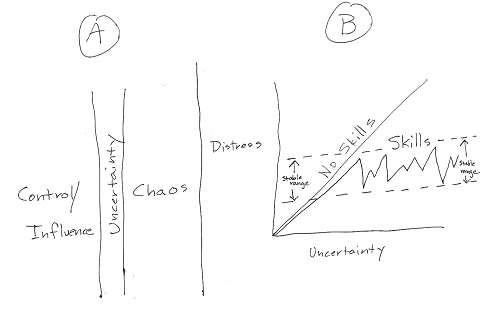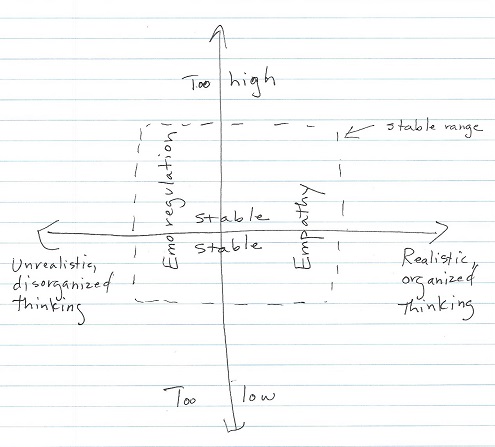In stressful times, our usual ways of managing feelings, thoughts, actions, and interactions may reach their limits.
People may be advised to “Stay calm” and “Be strong” and “Be nice.” But how? How does one become calm when one feels alarmed? How does one use strengths when one feels discouraged? How does one remember that the other person means well when we can’t find space away from each other?
Actually, the human brain has evolved to achieve these states skillfully and effectively. In hard times, we just need to activate these abilities efficiently.
I keep a set of handouts in page protectors at the table when I facilitate in-person individual and group counseling sessions. The handouts are primarily diagrams that provide context and support for insights clients are having during sessions.
Activating our abilities to help ourselves through hard times is usually a step-by-step process of learning, practicing, and implementing what we term, among my private counseling practice clients, “awareness skills.”
Here are links to the handouts we use in the order most clients find helpful. The handouts can be used in any order. I describe the concepts and include a duplicate link below.
- Approach vs. Avoid Reality Diagram.pdf
- Awareness Cards.pdf
- Expanded ABC Worksheet.pdf
- Common Cognitive Distortions with Simple Definitions.pdf
- Feelings-Thoughts Pie Charts .pdf
- Accessing Inner Wisdom After Flooding or Intellectualizing.pdf
- The Dialogue.pdf
I use “I-statements” in the narrative portions so readers can try these ideas on for themselves and see which ones are a fit.
Approach vs. Avoid Reality
“While shining the sun of self-kindness on myself and my life, I acknowledge how much I would prefer to dwell in ‘The Realm of Wishing Things Were Different.’ I acknowledge how avoidance of reality, at times, feels merciful. However, I accept that reality-based strategies are more likely to be effective than wishful thinking. I become aware of my feelings and thoughts so I can access my inner wisdom to help me make conscious choices about what to say and do next – or not say and not do.”
Approach vs. Avoid Reality Diagram.pdf
Awareness Cards
In group sessions, we cut these cards apart with scissors, then each of us arranges them on the table in front of us in a way that’s individually meaningful. The cards can be kept and reconsidered on other days.
“My brain is complex, the existence of myself as a human among humans is complex, and life brings what it brings. Wow! This is hard! I give myself a hug! There’s so much I can do nothing about!
However. I can use my own awareness to become the master of my attention, adjust my feelings to a stable range – not judge, suppress, or change them, just adjust! – and sort my thoughts into facts and beliefs. I can shift my attention to the facts. Then, I can consciously use skills to become aware of my values and priorities, strategize ways to live and act upon them, and open a vista of possibilities for myself.”
For assistance with thinking about one’s values, the Personal Values Card Sort may be helpful.
Expanded ABC Worksheet
In cognitive behavior therapy, we are asked to become aware of 1) what’s happened to create a reaction in us (A – activating event), 2) the beliefs we have about what should and shouldn’t be happening (B – beliefs), and 3) feelings that have arisen as a result of our beliefs (C – consequences). Then we’re asked to 4) challenge our beliefs with facts, then 5) reassure ourselves and devise a plan for when this sequence might happen again.
I have found the ABC approach necessary but not sufficient for the clients I serve. I have synthesized the essence of multiple cognitive therapy protocols into one worksheet. (I acknowledge the content is dense, uses some jargon, and may be difficult to use solo. I offer this work-in-progress in case it may be of service.)
Challenging Beliefs with Facts
Woo-whee, this is the hardest part! Beliefs can feel better than facts! And beliefs serve a function. For example, I don’t know for a fact that my local grocery store is stocked with bananas, but I believe it is. I don’t have to go check. Beliefs help with efficiency.
When beliefs aren’t based on facts or logic, they’re termed “cognitive distortions.” I distribute this handout along with the Expanded ABC Worksheet to help people look and re-look at the ways they’re thinking as they consider all the sections.
Common Cognitive Distortions with Simple Definitions.pdf
The Checklist of Cognitive Distortions by David Burns, Ph.D. may also be helpful. The explanation of common cognitive distortions at the end of this article is excellent.
Feelings-Thoughts Pie Charts
“If I imagine my brain’s decision-making ability as a pie chart, my brain probably works most effectively when I let my thoughts operate at about 75% and my feelings operate at about 25%. I use my awareness skills to monitor my inner ratio of thoughts to feelings. When feelings intensify, the feelings functions of my brain begin to overpower the thinking portions of my brain. If I don’t use my skills to adjust my feeling-thinking ratio, the feelings have a momentum of their own that may result in a trajectory that leads me to do and say things I didn’t intend. Once I’ve regained stability, I will ask myself, ‘What was I thinking?!’ and the answer is that I wasn’t thinking. My feelings overpowered my thinking. That’s why I have to constantly monitor my inner state and help myself stabilize when I notice my feelings begin to intensify.”
Feelings-Thoughts Pie Charts .pdf
Regaining Access to Inner Wisdom After Flooding or Intellectualizing
“If I allow my feelings to override my thinking, I may lose my ability to manage my feelings, thoughts, and actions. If I allow my thoughts to override my feelings, I may lose my ability to empathize and risk causing harm to myself and others through my words and actions. Awareness of both feelings and thoughts gives me access to my inner wisdom whereby my values and priorities can guide me.
If I think I am helpless to do anything, I may cause myself a state of panic. During panic, my feelings completely overpower my ability to think. Here’s the process I can use to help myself stabilize from panic.”
Accessing Inner Wisdom After Flooding or Intellectualizing .pdf
The Dialogue
The Dialogue is an adaptation of a communication protocol developed by Harville Hendrix, Ph.D.
Use Skills to Manage the Realities of Uncertainty and Distress
“I can control and influence what I can. As I reach the limits of what I can make as certain as I can, I approach the realm of uncertainty. I’m human and experience uncertainty as bordering on chaos. I cannot know what’s ahead. To help myself stabilize my feelings, thoughts, words, actions, and interactions, I can acknowledge the reality that I do feel distressed when I am uncertain. My job is not to try to wish or force distress and uncertainty to go away. My job is to acknowledge their realities. I will sense uncertainty and experience distress. I can use my skills to manage fluctuations within a stable range so I can endure and handle hardships for the long-haul.”

Using Skills to Manage Wild Feelings and Thoughts
“Sometimes my feelings and thoughts go wild. I may be hearing things and seeing things and believing things are true that don’t make sense. I may feel like I’m floating in the corner of the room watching myself. I may believe someone or something is in the next room and means me harm. I may have physical sensations that give me a sense of feeling out of control – a pounding heart, rapid pulse, sweating, pain in my chest.
I need to do a safety check for myself. Right here, right now, am I safe? If I’m not, I get myself to safety.
What are the facts about my physical symptoms? I make a list of them so, if I decide to seek medical care, I’ll know exactly what to report to my busy health care provider.
If I deem I am safe and not physically ill, I can help myself by saying to myself, ‘Right here, right now, I am safe and well. My feelings and thoughts have simply gone wild.’
Acknowledging the wildness gives me some options. Some wildness doesn’t give and I have to co-travel with it. I may be able to calm the wildness to a more stable range. Both options require the use of skills. I have many skills and am learning more.
Taking either path gives me enough consciousness to continue to empathize with myself and others, manage my words and actions, and be as kind to myself and others as I can.”

Here’s the full Awareness Skills Curriculum.
Here are summaries of the “big four” awareness skills:
- Attention management: “I choose to what I give my attention. I have the power to disengage, shift, and re-engage my attention as I choose.”
- Emotion regulation: “I am aware of my feelings and the intensity of my inner state. I can adjust the intensity up or down to foster my well-being and effectiveness.”
- Thoughts: “I can become aware of thoughts, sort them into ‘helpful’ and ‘unhelpful’ categories, differentiate between fact and opinion, and shift my attention to helpful, realistic thoughts. When addressing options, I can do a cost-benefit analysis with rank ordering.”
- Inner wisdom: “As a result of being aware of my feelings and thoughts, I can access my inner wisdom for guidance, strategies, and leadership based on my values and priorities.”
Here’s the Self-Care Checklist that helps people assess how they’re doing and offers ideas for what to add.
For people who have challenges with behaviors, including substance use, our guide may be of assistance: Help That Helps: A Kind, Research-Informed, Field-Tested Guide for People with Substance Use Concerns, by Anne Giles, M.A., M.S., L.P.C. and Sanjay Kishore, M.D., July 2019.
Finally, to pair a summary of what research suggests is helpful with self-kindness, please consider reading I Sing a Song of Myself.
Last revised 3/21/20
To be added: I Can Give Myself and Others a Better Time
The views expressed are mine alone and do not necessarily reflect the positions of my colleagues, clients, family members, or friends. This content is for informational purposes only and is not a substitute for medical or professional advice. Consult a qualified health care professional for personalized medical and professional advice.

